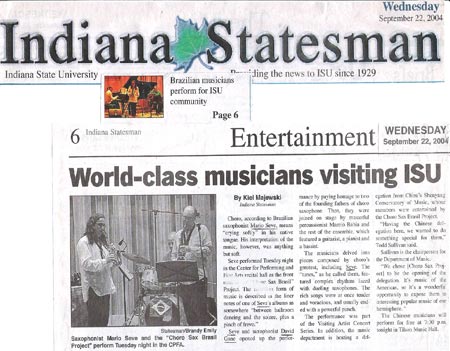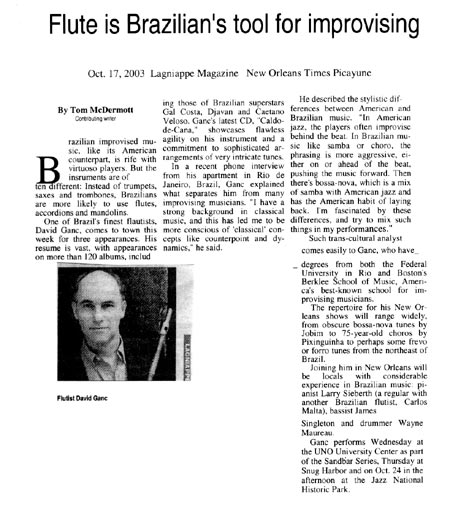Beyond Timeless Classics
Reviewed by Egídio Leitão
July 2005
Mário Sève & David Ganc
Pixinguinha + Benedito
Independent (2005)
Time: 53’15”
I will tip my hat off to Mário Sève and David Ganc — and I don’t even wear hats! Before you start thinking “oh no another Pixinguinha album,” let me reassure you this is not anything you have heard before. I’ll be honest with you: I also had that initial, erroneous reaction. I wondered what two accomplished musicians would be doing revisiting such familiar repertoire. Was I wrong! If you are familiar with Sève’s and Ganc’s releases, you know that excellence goes hand in hand with whatever these guys do. So, it is no wonder that they are here with an album with music by Pixinguinha and Benedito Lacerda only to amaze you and knock you off your feet.
Mário Sève (Rio de Janeiro, 1959) is a member of Aquarela Carioca and Nó em Pingo D’Água. What more can be said about this musician once you know he is a member of Brazil’s premier choro group?! In addition to several recordings with that group, Sève has also released acclaimed albums with Daniela Spielmann (Choros, Por Que Sax?, Biscoito Fino 2004) and Marcelo Fagerland (Bach & Pixinguinha, Sax, Flauta & Cravo, Núcleo Contemporâneo 2001). The other half of this duo, David Ganc (Rio de Janeiro, 1958), is also a celebrated musician who has been playing professionally since age 16. He has opened for Egberto Gismonti’s and Milton Nascimento’s shows and in 2004 released David Ganc & Quarteto de Cordas Guerra Peixe Interpretam Tom Jobim (Kuarup). Together, they have a lot more in common than simply playing saxophone and flute, arranging, composing or producing. They also share a passion for the best in Brazilian as attested by the albums they have recorded.
In Pixinguinha + Benedito, Mário and David are not alone. They produced and directed the album and also shared the wonders of the music with fellow friends, including Leandro Braga (piano), Jorginho do Pandeiro (pandeiro), Celsinho Silva (reco-reco), Toninho Ferragutti (acordeon), Wanderson Martins (cavaquinho, banjo), Cláudio Jorge (acoustic guitar) and a few others.
Right from the start, one of the first things you will notice that strikes you as a very different album with Pixinguinha music is that here you will not find the often-recorded classics “Carinhoso” and “Rosa.” Even though those songs are gorgeous examples of Pixinguinha’s music, Sève and Ganc opted to include other excellent music that well represent the genius Pixinguinha and Benedito Lacerda were. The choro-lundu “Cheguei” and choro-forró “Descendo a Serra” are two examples of how creative and elaborate Pixinguinha’s music was. Pixinguinha and Benedito expanded beyond the traditional choro repertoire and created gems such as the baião “Acorda Garota” and the vivacious frevo “Água Morna.” In contrast with the lively rhythm in “Água Morna,” we have the waltz “Glória,” with Ferragutti’s touching acordeon accompaniment. In closing the album, one more surprise: “Urubu Malandro,” the only track not composed by Pixinguinha or Benedito Lacerda.
Mário and David dare to bring to you Pixinguinha and Benedito’s music with a touch of freshness, boldness and a whole lot of class without missing a beat with these timeless classics. You can hear a couple of tracks from this album in David Ganc’s home page.










